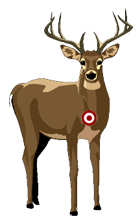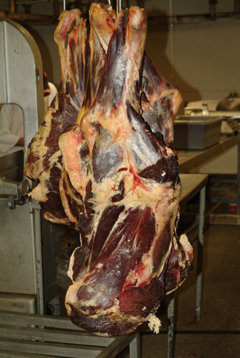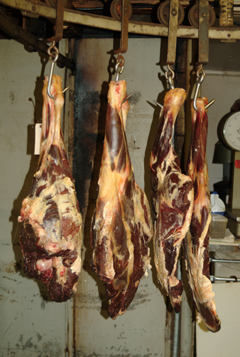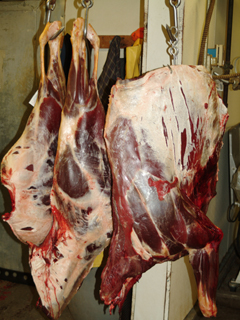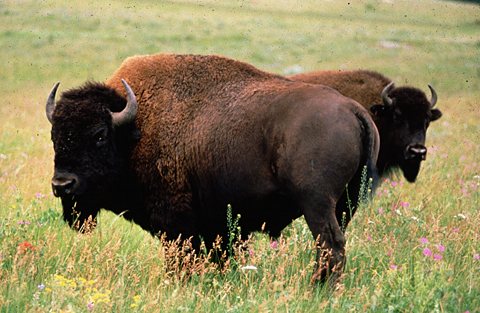Dressing the Kill
After expert marksmanship and well-honed tracking techniques, the next most urgent responsibility of every hunter was the field dressing of the carcass, which included removal of the “offal”—the paunch and intestines—and skinning. In the case of bison this might include some rough butchering for convenience in carrying the meat back to camp.
Elk were somewhat easier to dress out and cut up, and deer even more so. A skilled and experienced hunter would shoot only at a standing or slowly walking elk or deer, aiming for the center of an imaginary ten-inch circle halfway between the top of the back and the bottom of the belly, slightly behind the front leg. If he hit the bull’s eye, the animal would bleed quickly and die before running—which would toughen the meat. As with buffalo, field dressing of elk or deer required strength, a sharp knife, and a thorough knowledge of the animal’s anatomy, and much practice. The Corps’ hunters wouldn’t have known anything about bacteria, but they must have learned how to keep the meat edible and good-tasting as long as possible, which in the process would have limited bacterial contamination. First, the scent glands in the hind legs had to be removed to prevent tainting of the meat. Then the hunter needed to remove the entrails quickly but carefully, avoiding contamination of the body cavity with the contents of the bladder, bowel, intestine or stomach, and to keep his knife clean. The meat had to be kept free of hair, which could quickly ruin the flavor. Finally, it was important to allow the body cavity to cool and dry out as quickly as the weather permitted, to make it easier to butcher. Today, before butchering, both wild and domestic meat is hung for at least ten days at a temperature a few degrees above 32° Fahrenheit, to inhibit bacterial damage and yet allow natural enzymes to tenderize it. The Corps’ hunters and cooks seldom if ever could afford that luxury.
Infrequently, carelessness or uncontrollable circumstances resulted in blunders that may have been hard to excuse. François Labiche, who was inducted at St. Charles as a lower Missouri River waterman and soon proved useful as an interpreter, emerged as one of the more reliable hunters. He “killed 3 Geese flying” over the Columbia River, Clark wrote approvingly. Somehow, though, he grew careless a few days before the Corps left Fort Clatsop. To begin with, he evidently failed to regularly examine his rifle, and as a result confronted his quarry at a considerable disadvantage. Worse yet, he neglected to clean one of his elk thoroughly. Lewis summarized the details.
This morning at 11 OCk. the hunters arrived, having killed four Elk only Labuish it seems was the only hunter who fell in with the Elk and having by some accedent lost the fore sight of his gun shot a great number of times but killed only the number mentioned. as the elk were scattered we sent two parties for them, they returned in the evening with four skins and the flesh of three Elk, that of one of them having become putrid from the liver and pluck[1]Noah Webster, in his Compendious Dictionary of the English Language (1806) defined “pluck” as “the heart, liver and lights,” lights being the lungs. having been carelessly left in the animal all night.
Hauling the Meat to Camp
Although it was sometimes hard to get within rifle range of a buffalo herd in regions where they were heavily hunted by Indians, shooting them was the easier part. However, field dressing a buffalo was another matter. It involved a lot of time and energy, and handling two or more in a day, plus hauling the meat to camp, required the help of several men. Even lugging quarters of bison, elk or deer to the riverside or ocean beach certainly required “stout men” who were capable of bearing hardship in “a pretty considereable degree,” whether they were hunters or not. The captains often sent out a special detail of half a dozen men or more to bring in meat and hides.
On 13 December 1805, for instance, Drouillard and Shannon killed and “boochered” eighteen elk and left them in the woods. Two days later the immediate retrieval of all that meat was urgent. Clark took sixteen men and three canoes six miles up Lewis’s River on the rising tide, divided them into three parties, and then hiked them three or four miles each way to haul forty-four quarters of elk to the canoes. It is no wonder that, as he reported the next day, “Several men Complaining of hurting themselves Carry meet, &c.” He even packed some himself. One team, consisting of Ordway, Colter, Collins, Whitehouse and McNeal, lost their way with their last load and didn’t get back to the canoes until after dark. In sheer misery they “staid out all night without fire and in the rain.” It took another full, stormy day—”Certainly one of the worst days that ever was!”—to finish the job. But they were all proved to be stout men, capable of bearing bodily fatigue in a pretty considerable degree.
Sometimes their Indian neighbors pitched in, as at Fort Clatsop on 24 January 1806 when Drouillard and Lepage returned from hunting with “two deer and the flesh of three Elk & one Elk’s skin, having given the flesh of one other Elk which they killed and three Elk’s skins to the Indians as the price of their assistance in transporting the ballance of the meat to the Fort.” It was a bargain. The sea being quite rough near Point Adams, where the animals had been shot, six Clatsops and Chief Coboway “carryed [the meat and hides] on their backs about six miles, before the waves were sufficiently low to permit their being taken on board their canoes.”
Butchering
By the Corps’ standards, the average amount of usable meat cut from the carcass of a deer or elk was considerably less than that from a bison. Meat from a whitetail deer might come to only 32 lbs; from a mule deer, 40. A cow elk might dress out to 100 lbs, a bull elk to 150 pounds or more. The prime meat would be the tenderloins, the two large muscles on either side of the backbone. Next would come the hip and shoulder loins, from which a connective tissue, or fell, had to be removed to avoid tainting the meat with a gamey taste and odor. Finally, the hunter would take the shoulder and rump roasts. The neck and rib meat would likely have been ignored in the interest of saving time. Today all such pieces would be saved for processing along with beef fat (suet) or pork shoulder in a meat grinder to make bison burger, elk burger or deer burger.
Four quarters of a bison hanging from meathooks at a commercial game processor’s establishment. The two nearest the camera are hind quarters, which include the rumps and hind legs. The two partialy hidden pieces are forequarters without the shoulders. All four weigh 75 pounds or more each. A butcher will cut these up into steaks and roasts. The Corps’ cooks would not have fried or grilled the steaks, but would have cut the meat into chunks and boiled it, which would have been quicker than roasting, and would have retained all of the fat.
Here are four bison legs, called “broken quarters,” each one the lower half of a full quarter, and each weighing 25 lbs. or more. The two at left are from the hindquarters; those at right are from the forequarters. Notice the head of the femur, the shiny spot at the bottom end (actually top, near the hook) of the leg at extreme left. The Corps’ hunters needed to know the anatomy of the animal well enough to cut through the deeply hidden joint cleanly, without wasting meat. The femur was the best bone from which to obtain fatty, nutritious marrow.
These two elk hindquarters (left) and one forequarter (right), weigh an average of 75 lbs. each. The streaks in the thin outer layer of fat were made by the person who skinned the carcass, when his knife slipped.
Skinning is an exacting technique that requires a sharp knife and a steady hand. The latter is difficult to maintain in the rain or cold, or while the skinner is under assault by hordes of mosquitoes. The elk they ate on the coast were Cervus canadensis roosevelti, a sub-species of the Rocky Mountain elk.
This 75-lb. forequarter includes the neck, spine, ribs, and right foreleg of an elk. The meat in all of these photographs has been aged for many weeks in a controlled environment at a temperature no higher than 38° Fahrenheit. The fat and meat both are now dry on the surface, so the quarters are relatively easy to pick up, although they still would be awkward to carry–especially the forequarters. The Corps’ hunters had to struggle with meat that was slippery with warm blood and fat, which made the job much harder.
Elk Forequarter
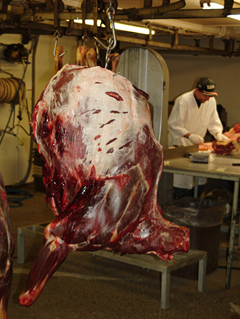
Courtesy H & H Meats, Missoula, Montana
Bison
Alexander Henry (d. 1814) listed the twenty pieces into which a bison carcass would be cut: “1 grosse bosse; 1 petite bosse; 2 dépouilles; 2 shoulders; 2 lourdes épaulettes; 2 filets; 2 thighs; 2 sides; 1 belly; 1 heart; 1 rump; 1 brisket; 1 backbone; 1 neck.”[2]Elliott Coues, ed., New Light on the Early History of the Greater North-West: The Manuscript Journals of Alexander Henry and of David Thompson, 1799-1814, 3 vols. (New York: F.P. Harper, 1897), … Continue reading
A mid-twentieth-century study of bison in which live weights were compared with dressed weights concluded that the average dressed weight of the meat, fat and bones of the four quarters, with the hide, head and entrails removed, averaged between 50 and 60 percent of the live weight. For example, a five-year-old bull weighing 1138 lbs. would dress out to 680 lbs., or 60 percent of its live weight.[3]Arthur F. Halloran, “Live and Dressed Weights of American Bison,” Journal of Mammalogy, vol. 38, no. 1 (February 1957), 139. The results of a 1999 archaeological study of Indian … Continue reading When it was boned back at camp, the total amount of useable meat would be approximately 400-450 lbs. However, the Corps’ hunters would usually take only the preferred cuts such as the hump, and the shoulders and rump if they were meaty enough to be easily “fleased” into ¼-inch-thick slices (“jerked”) for drying. The tallow from around the kidneys would be saved to enrich the stews. Long large thigh bones were similarly saved for their delicious marrow.
The liver, heart and tongue were considered delicacies. Among trappers the tongue often belonged to the hunter who made the kill. On New Years Day, 1806, “two of our hunters who Set out this morning returned in the evening haveing killed two Bucks Elks; they presented Capt. Lewis and my Self each a marrow bone and tongue on which we Suped.” Occasionally a hunter would shoot a bison and then discover it was overall too lean to be worth dressing out and carrying back to camp, so he would take the tongue and hump, containing the most fat, and leave the rest to rot. That practice, called “pot hunting,” was looked down upon by self-respecting hunters. The best hunters could tell at a glance whether an animal was fat or not.
The meat of the buffalo’s hump, although when boned-out it weighs only about five pounds, was considered a prime cut by frontiersmen 200 years ago. Sgt. Ordway, for example, tells of killing a bull on 27 June 1805 from which he and three other men “took out the hump and went down a Steep hill to get to water where we broiled [boiled?] the hump and eat a hearty meal of it.” Lewis was particularly fond of hump meat. Two days later, while on a trip from White Bear Islands to view today’s “Giant Spring,” he and Drewyer shot a bison and “took a parsel of the meat to camp it was in very good order; the hump and tongue of a fat buffaloe I esteem great delicasies.” Any Indians, had they been present to witness these incidents, would have been disgusted by their wastefulness.
Today, just as the bison has lost its magic–although not its majesty–the hump meat has lost its appeal to most gourmets. It is part of the chuck,[4]“Chuck,” synonymous with “chunk,” is any cut of beef between the horns and the ribs. OED, 1881. or shoulder section of the carcass, and although it is tasty, it is also fatty (over which, of course, the Corps would have salivated), tough, and laced with gristle. It is best cooked slowly in a liquid, like pot roast–”sauced,” as old-time cooks would have said. Along with buffalo tongue, it would have added a fine flavor to Charbonneau’s “boudin blanc.”[5]Leandra Zim Holland, Feasting and Fasting with Lewis & Clark: A Food and Social History of the Early 1800s (Emigrant, Montana: Old Yellowstone Publishing, 2003), 30, 50, 64, 135, 258.
Notes
| ↑1 | Noah Webster, in his Compendious Dictionary of the English Language (1806) defined “pluck” as “the heart, liver and lights,” lights being the lungs. |
|---|---|
| ↑2 | Elliott Coues, ed., New Light on the Early History of the Greater North-West: The Manuscript Journals of Alexander Henry and of David Thompson, 1799-1814, 3 vols. (New York: F.P. Harper, 1897), 1:446. The dépouille was the flesh between the ribs from the shoulder to the rump, on both sides; the lourdes épaulettes were shoulder pieces; the grosse bosse was the hump, composed of a number of thin bones separated by fatty flesh, which were attached to the thoraxic vertebrae. |
| ↑3 | Arthur F. Halloran, “Live and Dressed Weights of American Bison,” Journal of Mammalogy, vol. 38, no. 1 (February 1957), 139. The results of a 1999 archaeological study of Indian butchering practices can be found in “Social Structure,” by Leland C. Bement of Oklahoma University, at http://faculty-staff.ou.edu/B/Leland.C.Bement-1/Social%20Structure.html Accessed 11 February 2008. |
| ↑4 | “Chuck,” synonymous with “chunk,” is any cut of beef between the horns and the ribs. OED, 1881. |
| ↑5 | Leandra Zim Holland, Feasting and Fasting with Lewis & Clark: A Food and Social History of the Early 1800s (Emigrant, Montana: Old Yellowstone Publishing, 2003), 30, 50, 64, 135, 258. |
